Civil Engineering Technology Report: Complex Infrastructure Design
VerifiedAdded on 2021/01/01
|11
|3317
|366
Report
AI Summary
This report provides a comprehensive analysis of a civil engineering project involving the construction of an industrial complex. The report begins with an introduction outlining the project's scope, including earthworks, foundation design, and the need for culverts and underpasses due to a nearby river. Task 1 delves into earthworks, equipment, and techniques, including land grading methods and the use of heavy machinery. It also discusses methods for creating complex foundations, piling works, and drainage systems, as well as the design and construction of culverts and underpasses. Furthermore, it explores methods for deep excavation and slope stability. Task 2 focuses on identifying hazards, risks, and safety arrangements in confined spaces, developing a safety plan, risk assessments, and method statements. It also addresses health and safety legislation and codes of practice. Task 3 evaluates environmental, quality, geotechnical, and economic contexts of the project, proposing solutions for sustainable construction. Finally, Task 4 explores methods and techniques for highway design and infrastructure access, as well as bridge and highway foundation construction. The report emphasizes the importance of safety, environmental considerations, and economic feasibility in civil engineering projects.

CIVIL ENGINEERING
TECHNOLOGY
TECHNOLOGY
Paraphrase This Document
Need a fresh take? Get an instant paraphrase of this document with our AI Paraphraser

TABLE OF CONTENTS
INTRODUCTION...........................................................................................................................1
TASK 1............................................................................................................................................1
Earthworks, equipment and techniques.......................................................................................1
Methods to create complex foundations, piling work and drainage work...................................1
Culverts and underpasses and methods used in culvert and underpass construction..................2
Methods utilised in complex earth moving operations................................................................3
Methods used in ground and slop stability..................................................................................3
TASK 2............................................................................................................................................4
Identification of Hazards, risks and safety arrangements while working in confined spaces or
structures or any temporary works..............................................................................................4
Develop a Safety plan, risk assessments and method statements................................................4
Health and safety legislation and codes of practice at engineering sites such as provided in the
given scenario..............................................................................................................................5
Justification of Site safety plan, risk assessments and method statements report.......................5
TASK 3............................................................................................................................................6
Explore, evaluate and propose environmental, quality, geotechnical and economic contests of
a civil engineering problem.........................................................................................................6
Proposal for identifying environmental, geotechnical, quality and economic contexts of the
problem........................................................................................................................................6
TASK 4............................................................................................................................................7
a) Methods and techniques which will be used in highway design and a proposal for the new
infrastructure access for project...................................................................................................7
b) Methods and techniques used to create bridge foundations and flexible highway
construction foundations and key criteria including key geotechnical parameters.....................7
REFERENCES................................................................................................................................9
INTRODUCTION...........................................................................................................................1
TASK 1............................................................................................................................................1
Earthworks, equipment and techniques.......................................................................................1
Methods to create complex foundations, piling work and drainage work...................................1
Culverts and underpasses and methods used in culvert and underpass construction..................2
Methods utilised in complex earth moving operations................................................................3
Methods used in ground and slop stability..................................................................................3
TASK 2............................................................................................................................................4
Identification of Hazards, risks and safety arrangements while working in confined spaces or
structures or any temporary works..............................................................................................4
Develop a Safety plan, risk assessments and method statements................................................4
Health and safety legislation and codes of practice at engineering sites such as provided in the
given scenario..............................................................................................................................5
Justification of Site safety plan, risk assessments and method statements report.......................5
TASK 3............................................................................................................................................6
Explore, evaluate and propose environmental, quality, geotechnical and economic contests of
a civil engineering problem.........................................................................................................6
Proposal for identifying environmental, geotechnical, quality and economic contexts of the
problem........................................................................................................................................6
TASK 4............................................................................................................................................7
a) Methods and techniques which will be used in highway design and a proposal for the new
infrastructure access for project...................................................................................................7
b) Methods and techniques used to create bridge foundations and flexible highway
construction foundations and key criteria including key geotechnical parameters.....................7
REFERENCES................................................................................................................................9
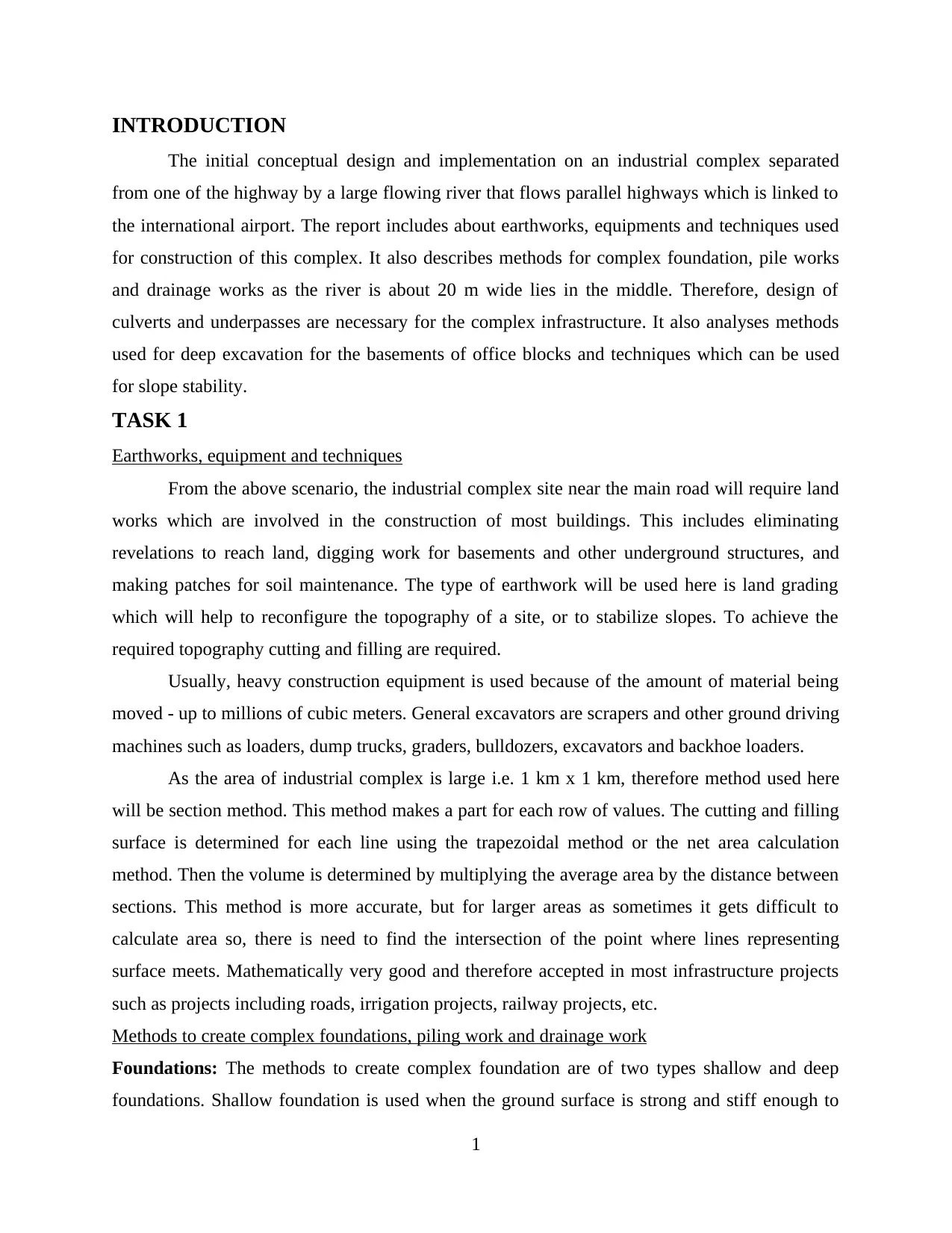
INTRODUCTION
The initial conceptual design and implementation on an industrial complex separated
from one of the highway by a large flowing river that flows parallel highways which is linked to
the international airport. The report includes about earthworks, equipments and techniques used
for construction of this complex. It also describes methods for complex foundation, pile works
and drainage works as the river is about 20 m wide lies in the middle. Therefore, design of
culverts and underpasses are necessary for the complex infrastructure. It also analyses methods
used for deep excavation for the basements of office blocks and techniques which can be used
for slope stability.
TASK 1
Earthworks, equipment and techniques
From the above scenario, the industrial complex site near the main road will require land
works which are involved in the construction of most buildings. This includes eliminating
revelations to reach land, digging work for basements and other underground structures, and
making patches for soil maintenance. The type of earthwork will be used here is land grading
which will help to reconfigure the topography of a site, or to stabilize slopes. To achieve the
required topography cutting and filling are required.
Usually, heavy construction equipment is used because of the amount of material being
moved - up to millions of cubic meters. General excavators are scrapers and other ground driving
machines such as loaders, dump trucks, graders, bulldozers, excavators and backhoe loaders.
As the area of industrial complex is large i.e. 1 km x 1 km, therefore method used here
will be section method. This method makes a part for each row of values. The cutting and filling
surface is determined for each line using the trapezoidal method or the net area calculation
method. Then the volume is determined by multiplying the average area by the distance between
sections. This method is more accurate, but for larger areas as sometimes it gets difficult to
calculate area so, there is need to find the intersection of the point where lines representing
surface meets. Mathematically very good and therefore accepted in most infrastructure projects
such as projects including roads, irrigation projects, railway projects, etc.
Methods to create complex foundations, piling work and drainage work
Foundations: The methods to create complex foundation are of two types shallow and deep
foundations. Shallow foundation is used when the ground surface is strong and stiff enough to
1
The initial conceptual design and implementation on an industrial complex separated
from one of the highway by a large flowing river that flows parallel highways which is linked to
the international airport. The report includes about earthworks, equipments and techniques used
for construction of this complex. It also describes methods for complex foundation, pile works
and drainage works as the river is about 20 m wide lies in the middle. Therefore, design of
culverts and underpasses are necessary for the complex infrastructure. It also analyses methods
used for deep excavation for the basements of office blocks and techniques which can be used
for slope stability.
TASK 1
Earthworks, equipment and techniques
From the above scenario, the industrial complex site near the main road will require land
works which are involved in the construction of most buildings. This includes eliminating
revelations to reach land, digging work for basements and other underground structures, and
making patches for soil maintenance. The type of earthwork will be used here is land grading
which will help to reconfigure the topography of a site, or to stabilize slopes. To achieve the
required topography cutting and filling are required.
Usually, heavy construction equipment is used because of the amount of material being
moved - up to millions of cubic meters. General excavators are scrapers and other ground driving
machines such as loaders, dump trucks, graders, bulldozers, excavators and backhoe loaders.
As the area of industrial complex is large i.e. 1 km x 1 km, therefore method used here
will be section method. This method makes a part for each row of values. The cutting and filling
surface is determined for each line using the trapezoidal method or the net area calculation
method. Then the volume is determined by multiplying the average area by the distance between
sections. This method is more accurate, but for larger areas as sometimes it gets difficult to
calculate area so, there is need to find the intersection of the point where lines representing
surface meets. Mathematically very good and therefore accepted in most infrastructure projects
such as projects including roads, irrigation projects, railway projects, etc.
Methods to create complex foundations, piling work and drainage work
Foundations: The methods to create complex foundation are of two types shallow and deep
foundations. Shallow foundation is used when the ground surface is strong and stiff enough to
1
⊘ This is a preview!⊘
Do you want full access?
Subscribe today to unlock all pages.

Trusted by 1+ million students worldwide
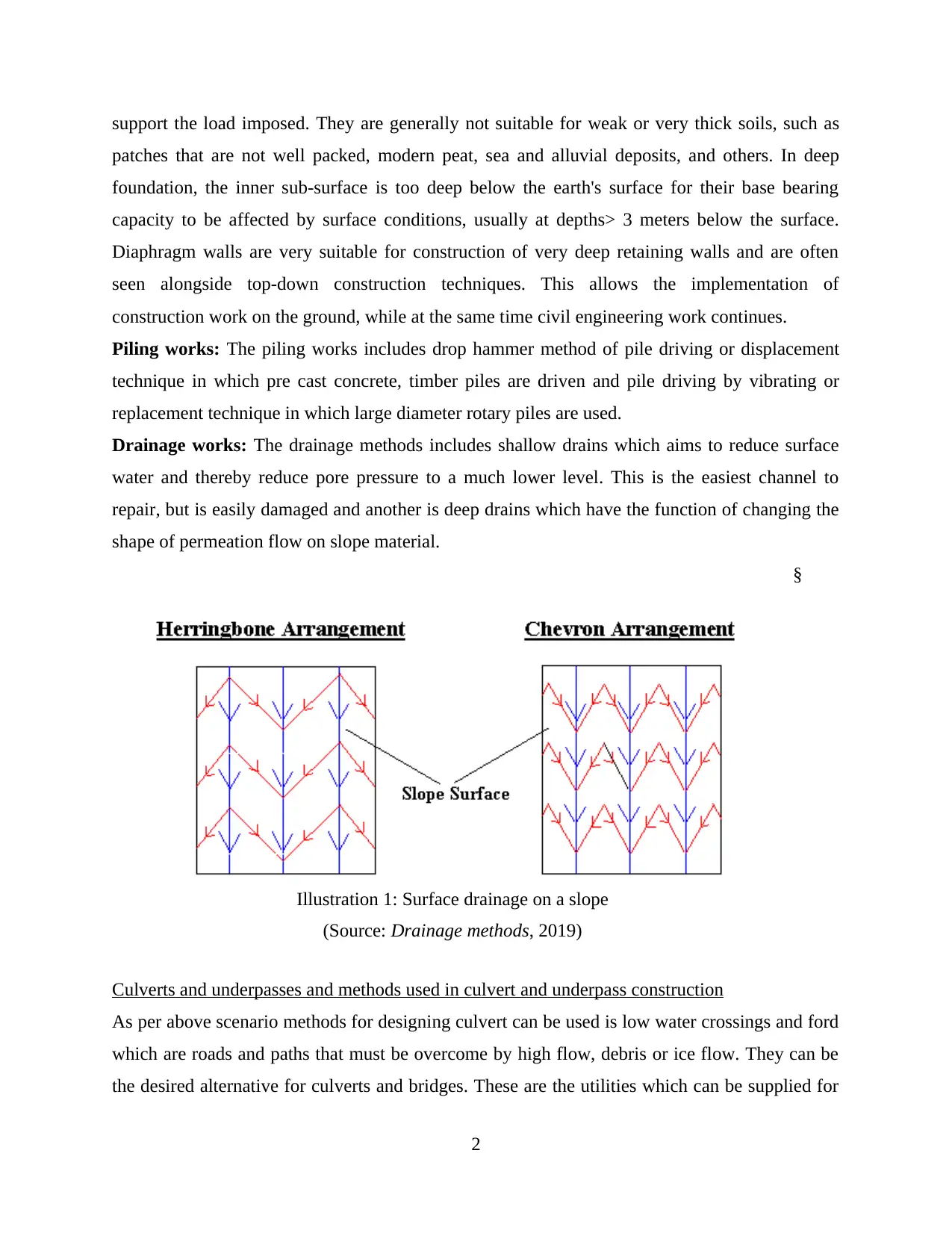
support the load imposed. They are generally not suitable for weak or very thick soils, such as
patches that are not well packed, modern peat, sea and alluvial deposits, and others. In deep
foundation, the inner sub-surface is too deep below the earth's surface for their base bearing
capacity to be affected by surface conditions, usually at depths> 3 meters below the surface.
Diaphragm walls are very suitable for construction of very deep retaining walls and are often
seen alongside top-down construction techniques. This allows the implementation of
construction work on the ground, while at the same time civil engineering work continues.
Piling works: The piling works includes drop hammer method of pile driving or displacement
technique in which pre cast concrete, timber piles are driven and pile driving by vibrating or
replacement technique in which large diameter rotary piles are used.
Drainage works: The drainage methods includes shallow drains which aims to reduce surface
water and thereby reduce pore pressure to a much lower level. This is the easiest channel to
repair, but is easily damaged and another is deep drains which have the function of changing the
shape of permeation flow on slope material.
Illustration 1: Surface drainage on a slope
(Source: Drainage methods, 2019)
§
Culverts and underpasses and methods used in culvert and underpass construction
As per above scenario methods for designing culvert can be used is low water crossings and ford
which are roads and paths that must be overcome by high flow, debris or ice flow. They can be
the desired alternative for culverts and bridges. These are the utilities which can be supplied for
2
patches that are not well packed, modern peat, sea and alluvial deposits, and others. In deep
foundation, the inner sub-surface is too deep below the earth's surface for their base bearing
capacity to be affected by surface conditions, usually at depths> 3 meters below the surface.
Diaphragm walls are very suitable for construction of very deep retaining walls and are often
seen alongside top-down construction techniques. This allows the implementation of
construction work on the ground, while at the same time civil engineering work continues.
Piling works: The piling works includes drop hammer method of pile driving or displacement
technique in which pre cast concrete, timber piles are driven and pile driving by vibrating or
replacement technique in which large diameter rotary piles are used.
Drainage works: The drainage methods includes shallow drains which aims to reduce surface
water and thereby reduce pore pressure to a much lower level. This is the easiest channel to
repair, but is easily damaged and another is deep drains which have the function of changing the
shape of permeation flow on slope material.
Illustration 1: Surface drainage on a slope
(Source: Drainage methods, 2019)
§
Culverts and underpasses and methods used in culvert and underpass construction
As per above scenario methods for designing culvert can be used is low water crossings and ford
which are roads and paths that must be overcome by high flow, debris or ice flow. They can be
the desired alternative for culverts and bridges. These are the utilities which can be supplied for
2
Paraphrase This Document
Need a fresh take? Get an instant paraphrase of this document with our AI Paraphraser
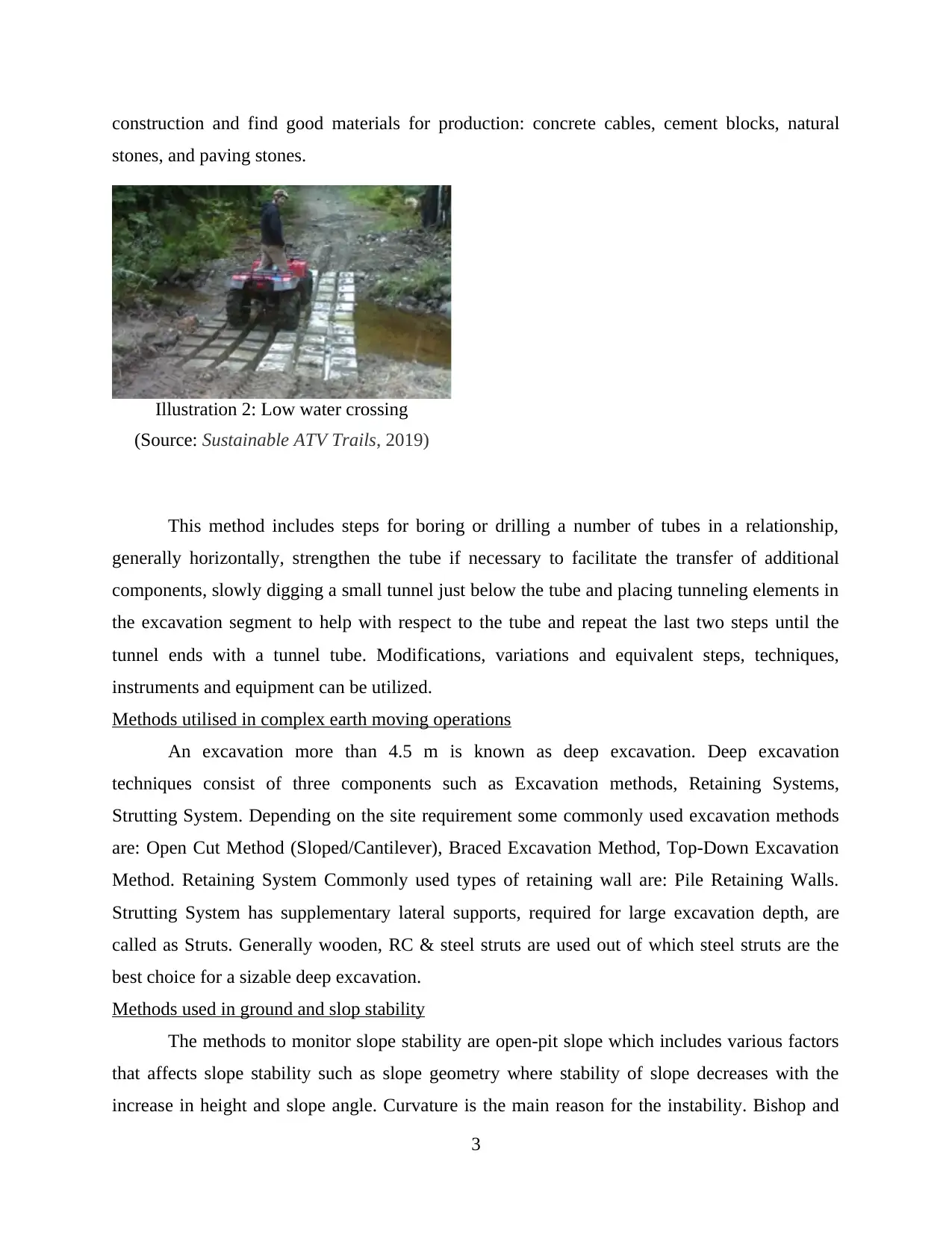
construction and find good materials for production: concrete cables, cement blocks, natural
stones, and paving stones.
Illustration 2: Low water crossing
(Source: Sustainable ATV Trails, 2019)
This method includes steps for boring or drilling a number of tubes in a relationship,
generally horizontally, strengthen the tube if necessary to facilitate the transfer of additional
components, slowly digging a small tunnel just below the tube and placing tunneling elements in
the excavation segment to help with respect to the tube and repeat the last two steps until the
tunnel ends with a tunnel tube. Modifications, variations and equivalent steps, techniques,
instruments and equipment can be utilized.
Methods utilised in complex earth moving operations
An excavation more than 4.5 m is known as deep excavation. Deep excavation
techniques consist of three components such as Excavation methods, Retaining Systems,
Strutting System. Depending on the site requirement some commonly used excavation methods
are: Open Cut Method (Sloped/Cantilever), Braced Excavation Method, Top-Down Excavation
Method. Retaining System Commonly used types of retaining wall are: Pile Retaining Walls.
Strutting System has supplementary lateral supports, required for large excavation depth, are
called as Struts. Generally wooden, RC & steel struts are used out of which steel struts are the
best choice for a sizable deep excavation.
Methods used in ground and slop stability
The methods to monitor slope stability are open-pit slope which includes various factors
that affects slope stability such as slope geometry where stability of slope decreases with the
increase in height and slope angle. Curvature is the main reason for the instability. Bishop and
3
stones, and paving stones.
Illustration 2: Low water crossing
(Source: Sustainable ATV Trails, 2019)
This method includes steps for boring or drilling a number of tubes in a relationship,
generally horizontally, strengthen the tube if necessary to facilitate the transfer of additional
components, slowly digging a small tunnel just below the tube and placing tunneling elements in
the excavation segment to help with respect to the tube and repeat the last two steps until the
tunnel ends with a tunnel tube. Modifications, variations and equivalent steps, techniques,
instruments and equipment can be utilized.
Methods utilised in complex earth moving operations
An excavation more than 4.5 m is known as deep excavation. Deep excavation
techniques consist of three components such as Excavation methods, Retaining Systems,
Strutting System. Depending on the site requirement some commonly used excavation methods
are: Open Cut Method (Sloped/Cantilever), Braced Excavation Method, Top-Down Excavation
Method. Retaining System Commonly used types of retaining wall are: Pile Retaining Walls.
Strutting System has supplementary lateral supports, required for large excavation depth, are
called as Struts. Generally wooden, RC & steel struts are used out of which steel struts are the
best choice for a sizable deep excavation.
Methods used in ground and slop stability
The methods to monitor slope stability are open-pit slope which includes various factors
that affects slope stability such as slope geometry where stability of slope decreases with the
increase in height and slope angle. Curvature is the main reason for the instability. Bishop and
3

ordinary methods of slope stability which helps to determine the factor of safety for the slope
undergoing seepage. Other technique to stable the soil is to reduce driving forces in which
external forces acting on soil mass can be balanced. The deterministic approach involves various
techniques, such as limit equilibrium methods (LEMs), limit analysis (LA), finite element
analysis (FEM) and finite difference method (FDM). Optimization is different Engineering has
the advantage of solving slope stability problem. From simple optimization techniques, like
Linear, non-linear programming, quadratic programming, dynamic programming, internal point
methods and more.
TASK 2
Identification of Hazards, risks and safety arrangements while working in confined spaces or
structures or any temporary works
Hazards and risks while working in confined spaces or structures
One of the major hazard working in confined spaces or structures is working at heights.
There are multiple risks associated with accessibility and mobility in working at high
places. Any human errors or failures can create major risks of any kind of fatal accidents.
Another hazard and risk associated is collapsing of a building. Collapsing of a building is
a risk because if measures are not taken then it can change into a serious hazards.
Moving construction objects within a confined space is also a risk as it proper safety
arrangements are not done then it can change into a hazardous situation.
Safety arrangements while working in confined spaces or structures
By providing proper training of working in confined spaces or structures so that any kind
of risk or hazard can be minimized (Qian and Lin, 2016).
Using and implementing all kind of protective systems and equipments for all the people
working within a construction site and especially within a confined space.
Develop a Safety plan, risk assessments and method statements
Safety plan
A safety plan comprises of a strategic action plan which is a part of business plan.
Responsibilities of a supervisor: Supervisor plays an important part in maintaining and
creating safety at construction site. He should implement all kinds of control, risk and
hazard methods to avoid any kind of causalities.
4
undergoing seepage. Other technique to stable the soil is to reduce driving forces in which
external forces acting on soil mass can be balanced. The deterministic approach involves various
techniques, such as limit equilibrium methods (LEMs), limit analysis (LA), finite element
analysis (FEM) and finite difference method (FDM). Optimization is different Engineering has
the advantage of solving slope stability problem. From simple optimization techniques, like
Linear, non-linear programming, quadratic programming, dynamic programming, internal point
methods and more.
TASK 2
Identification of Hazards, risks and safety arrangements while working in confined spaces or
structures or any temporary works
Hazards and risks while working in confined spaces or structures
One of the major hazard working in confined spaces or structures is working at heights.
There are multiple risks associated with accessibility and mobility in working at high
places. Any human errors or failures can create major risks of any kind of fatal accidents.
Another hazard and risk associated is collapsing of a building. Collapsing of a building is
a risk because if measures are not taken then it can change into a serious hazards.
Moving construction objects within a confined space is also a risk as it proper safety
arrangements are not done then it can change into a hazardous situation.
Safety arrangements while working in confined spaces or structures
By providing proper training of working in confined spaces or structures so that any kind
of risk or hazard can be minimized (Qian and Lin, 2016).
Using and implementing all kind of protective systems and equipments for all the people
working within a construction site and especially within a confined space.
Develop a Safety plan, risk assessments and method statements
Safety plan
A safety plan comprises of a strategic action plan which is a part of business plan.
Responsibilities of a supervisor: Supervisor plays an important part in maintaining and
creating safety at construction site. He should implement all kinds of control, risk and
hazard methods to avoid any kind of causalities.
4
⊘ This is a preview!⊘
Do you want full access?
Subscribe today to unlock all pages.

Trusted by 1+ million students worldwide
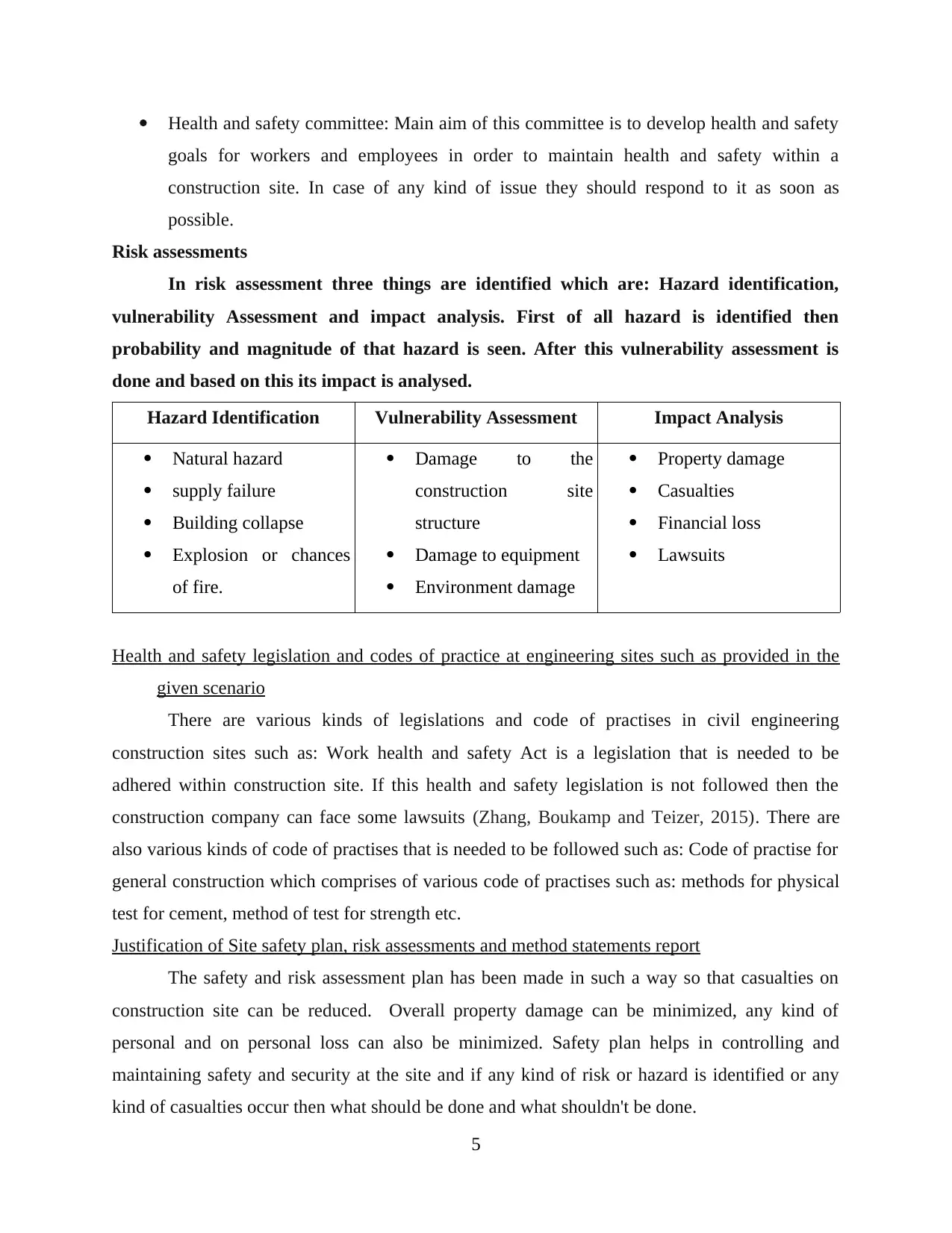
Health and safety committee: Main aim of this committee is to develop health and safety
goals for workers and employees in order to maintain health and safety within a
construction site. In case of any kind of issue they should respond to it as soon as
possible.
Risk assessments
In risk assessment three things are identified which are: Hazard identification,
vulnerability Assessment and impact analysis. First of all hazard is identified then
probability and magnitude of that hazard is seen. After this vulnerability assessment is
done and based on this its impact is analysed.
Hazard Identification Vulnerability Assessment Impact Analysis
Natural hazard
supply failure
Building collapse
Explosion or chances
of fire.
Damage to the
construction site
structure
Damage to equipment
Environment damage
Property damage
Casualties
Financial loss
Lawsuits
Health and safety legislation and codes of practice at engineering sites such as provided in the
given scenario
There are various kinds of legislations and code of practises in civil engineering
construction sites such as: Work health and safety Act is a legislation that is needed to be
adhered within construction site. If this health and safety legislation is not followed then the
construction company can face some lawsuits (Zhang, Boukamp and Teizer, 2015). There are
also various kinds of code of practises that is needed to be followed such as: Code of practise for
general construction which comprises of various code of practises such as: methods for physical
test for cement, method of test for strength etc.
Justification of Site safety plan, risk assessments and method statements report
The safety and risk assessment plan has been made in such a way so that casualties on
construction site can be reduced. Overall property damage can be minimized, any kind of
personal and on personal loss can also be minimized. Safety plan helps in controlling and
maintaining safety and security at the site and if any kind of risk or hazard is identified or any
kind of casualties occur then what should be done and what shouldn't be done.
5
goals for workers and employees in order to maintain health and safety within a
construction site. In case of any kind of issue they should respond to it as soon as
possible.
Risk assessments
In risk assessment three things are identified which are: Hazard identification,
vulnerability Assessment and impact analysis. First of all hazard is identified then
probability and magnitude of that hazard is seen. After this vulnerability assessment is
done and based on this its impact is analysed.
Hazard Identification Vulnerability Assessment Impact Analysis
Natural hazard
supply failure
Building collapse
Explosion or chances
of fire.
Damage to the
construction site
structure
Damage to equipment
Environment damage
Property damage
Casualties
Financial loss
Lawsuits
Health and safety legislation and codes of practice at engineering sites such as provided in the
given scenario
There are various kinds of legislations and code of practises in civil engineering
construction sites such as: Work health and safety Act is a legislation that is needed to be
adhered within construction site. If this health and safety legislation is not followed then the
construction company can face some lawsuits (Zhang, Boukamp and Teizer, 2015). There are
also various kinds of code of practises that is needed to be followed such as: Code of practise for
general construction which comprises of various code of practises such as: methods for physical
test for cement, method of test for strength etc.
Justification of Site safety plan, risk assessments and method statements report
The safety and risk assessment plan has been made in such a way so that casualties on
construction site can be reduced. Overall property damage can be minimized, any kind of
personal and on personal loss can also be minimized. Safety plan helps in controlling and
maintaining safety and security at the site and if any kind of risk or hazard is identified or any
kind of casualties occur then what should be done and what shouldn't be done.
5
Paraphrase This Document
Need a fresh take? Get an instant paraphrase of this document with our AI Paraphraser
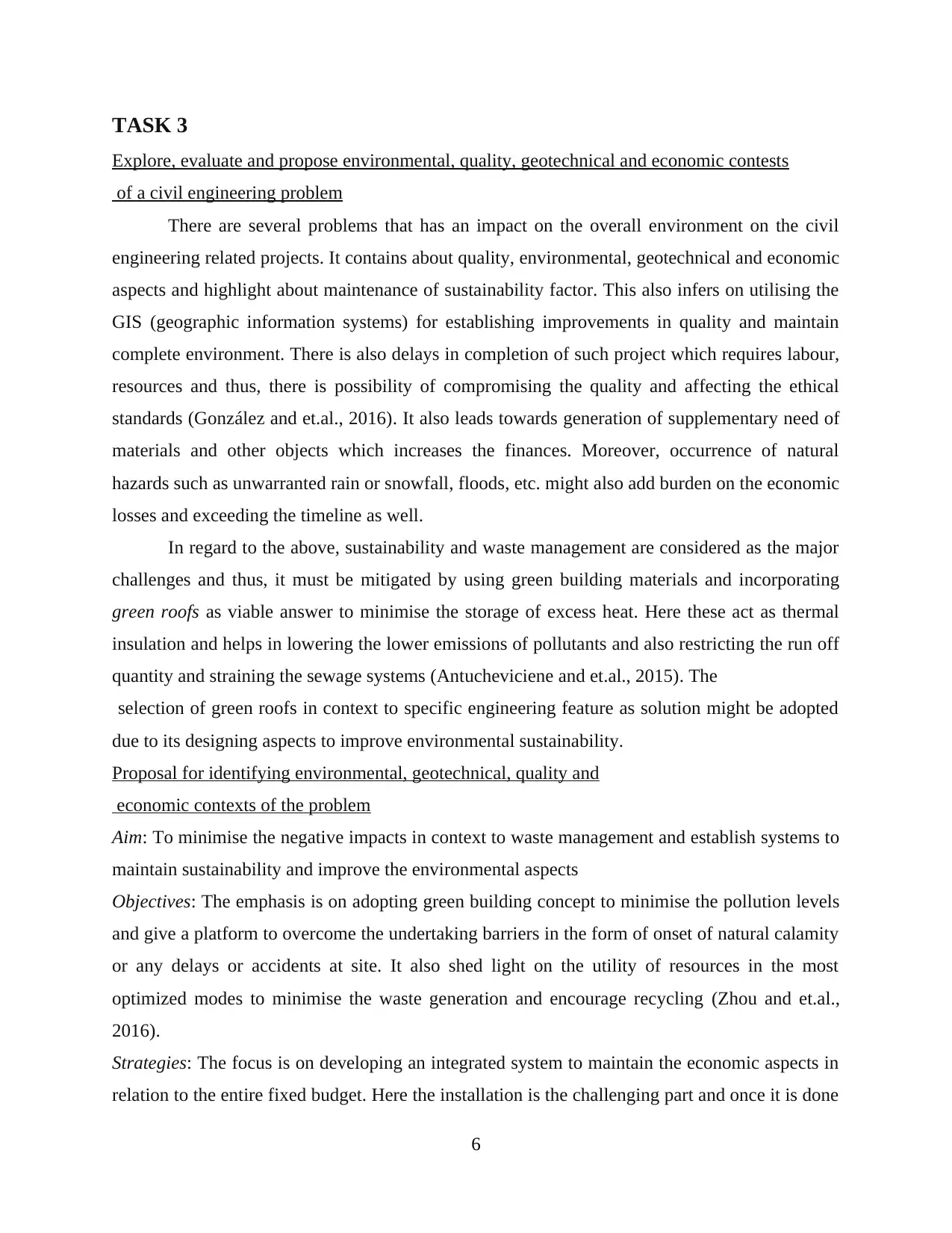
TASK 3
Explore, evaluate and propose environmental, quality, geotechnical and economic contests
of a civil engineering problem
There are several problems that has an impact on the overall environment on the civil
engineering related projects. It contains about quality, environmental, geotechnical and economic
aspects and highlight about maintenance of sustainability factor. This also infers on utilising the
GIS (geographic information systems) for establishing improvements in quality and maintain
complete environment. There is also delays in completion of such project which requires labour,
resources and thus, there is possibility of compromising the quality and affecting the ethical
standards (González and et.al., 2016). It also leads towards generation of supplementary need of
materials and other objects which increases the finances. Moreover, occurrence of natural
hazards such as unwarranted rain or snowfall, floods, etc. might also add burden on the economic
losses and exceeding the timeline as well.
In regard to the above, sustainability and waste management are considered as the major
challenges and thus, it must be mitigated by using green building materials and incorporating
green roofs as viable answer to minimise the storage of excess heat. Here these act as thermal
insulation and helps in lowering the lower emissions of pollutants and also restricting the run off
quantity and straining the sewage systems (Antucheviciene and et.al., 2015). The
selection of green roofs in context to specific engineering feature as solution might be adopted
due to its designing aspects to improve environmental sustainability.
Proposal for identifying environmental, geotechnical, quality and
economic contexts of the problem
Aim: To minimise the negative impacts in context to waste management and establish systems to
maintain sustainability and improve the environmental aspects
Objectives: The emphasis is on adopting green building concept to minimise the pollution levels
and give a platform to overcome the undertaking barriers in the form of onset of natural calamity
or any delays or accidents at site. It also shed light on the utility of resources in the most
optimized modes to minimise the waste generation and encourage recycling (Zhou and et.al.,
2016).
Strategies: The focus is on developing an integrated system to maintain the economic aspects in
relation to the entire fixed budget. Here the installation is the challenging part and once it is done
6
Explore, evaluate and propose environmental, quality, geotechnical and economic contests
of a civil engineering problem
There are several problems that has an impact on the overall environment on the civil
engineering related projects. It contains about quality, environmental, geotechnical and economic
aspects and highlight about maintenance of sustainability factor. This also infers on utilising the
GIS (geographic information systems) for establishing improvements in quality and maintain
complete environment. There is also delays in completion of such project which requires labour,
resources and thus, there is possibility of compromising the quality and affecting the ethical
standards (González and et.al., 2016). It also leads towards generation of supplementary need of
materials and other objects which increases the finances. Moreover, occurrence of natural
hazards such as unwarranted rain or snowfall, floods, etc. might also add burden on the economic
losses and exceeding the timeline as well.
In regard to the above, sustainability and waste management are considered as the major
challenges and thus, it must be mitigated by using green building materials and incorporating
green roofs as viable answer to minimise the storage of excess heat. Here these act as thermal
insulation and helps in lowering the lower emissions of pollutants and also restricting the run off
quantity and straining the sewage systems (Antucheviciene and et.al., 2015). The
selection of green roofs in context to specific engineering feature as solution might be adopted
due to its designing aspects to improve environmental sustainability.
Proposal for identifying environmental, geotechnical, quality and
economic contexts of the problem
Aim: To minimise the negative impacts in context to waste management and establish systems to
maintain sustainability and improve the environmental aspects
Objectives: The emphasis is on adopting green building concept to minimise the pollution levels
and give a platform to overcome the undertaking barriers in the form of onset of natural calamity
or any delays or accidents at site. It also shed light on the utility of resources in the most
optimized modes to minimise the waste generation and encourage recycling (Zhou and et.al.,
2016).
Strategies: The focus is on developing an integrated system to maintain the economic aspects in
relation to the entire fixed budget. Here the installation is the challenging part and once it is done
6

through giving clear instructions to the labourers. Additionally, this innovative concept helped in
terms of using a comprehensive watering system and drainage system and maintenance of green
building systems (Houghtalen, Osman and Hwang, 2016). Thus, it aids in ensuring the
optimization of costs and managing the climatic conditions while maintaining project.
TASK 4
a) Methods and techniques which will be used in highway design and a proposal for the new
infrastructure access for project
Road construction techniques are mainly of two types which are as follows-
Construction Staking: before starting the construction activities, it is very important to
design the information that has to be moves from the plan to the ground and it can only
be executed by staking. Slope stakes are one of the effective ways to make sure the
compliance with the standard of design as well as to keep soil disturbance to an implicit
minimum. Stakes, marketing point on roads are typically obliterated during the clearing
as well as grubbing stage.
Clearing and Grubbing of the road construction Area: Clearing and grubbing means
to prepare the right area for construction. All the trees are cut down, stumps and organic
dust are also cleared to prepare the area for road. Before preparing road, it requires the
area to be plan without any trees and stumps.
Thus, before planning the road, these three methods must be followed before and during the
construction.
b) Methods and techniques used to create bridge foundations and flexible highway construction
foundations and key criteria including key geotechnical parameters
Methods and techniques used to create bridge foundations
Shallow foundations: This is known as spread footings where foundation of bridge is
first excavating earth till bottom of footing and the first construction of footing is done.
Footing takes the rigorous load of the spreads and column over a large area to maintain
actual weight on the soil does not exceed the safe bearing capacity of the soil.
Geotechnical key criteria key criteria for this is rate at which the compression of the soil
occurs. In this plasticity of solid is considered which is based on strength, plasticity and
compressibility.
7
terms of using a comprehensive watering system and drainage system and maintenance of green
building systems (Houghtalen, Osman and Hwang, 2016). Thus, it aids in ensuring the
optimization of costs and managing the climatic conditions while maintaining project.
TASK 4
a) Methods and techniques which will be used in highway design and a proposal for the new
infrastructure access for project
Road construction techniques are mainly of two types which are as follows-
Construction Staking: before starting the construction activities, it is very important to
design the information that has to be moves from the plan to the ground and it can only
be executed by staking. Slope stakes are one of the effective ways to make sure the
compliance with the standard of design as well as to keep soil disturbance to an implicit
minimum. Stakes, marketing point on roads are typically obliterated during the clearing
as well as grubbing stage.
Clearing and Grubbing of the road construction Area: Clearing and grubbing means
to prepare the right area for construction. All the trees are cut down, stumps and organic
dust are also cleared to prepare the area for road. Before preparing road, it requires the
area to be plan without any trees and stumps.
Thus, before planning the road, these three methods must be followed before and during the
construction.
b) Methods and techniques used to create bridge foundations and flexible highway construction
foundations and key criteria including key geotechnical parameters
Methods and techniques used to create bridge foundations
Shallow foundations: This is known as spread footings where foundation of bridge is
first excavating earth till bottom of footing and the first construction of footing is done.
Footing takes the rigorous load of the spreads and column over a large area to maintain
actual weight on the soil does not exceed the safe bearing capacity of the soil.
Geotechnical key criteria key criteria for this is rate at which the compression of the soil
occurs. In this plasticity of solid is considered which is based on strength, plasticity and
compressibility.
7
⊘ This is a preview!⊘
Do you want full access?
Subscribe today to unlock all pages.

Trusted by 1+ million students worldwide
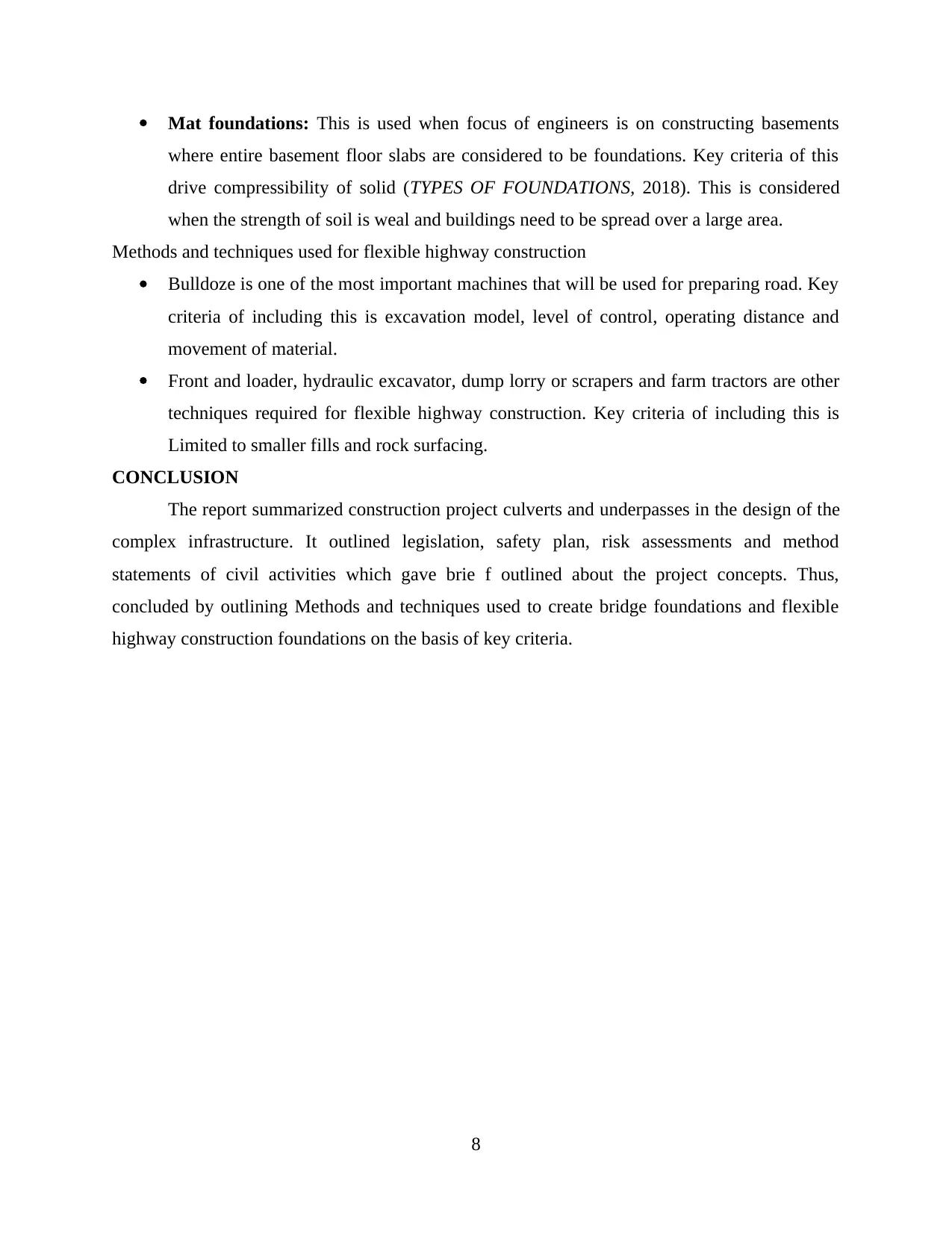
Mat foundations: This is used when focus of engineers is on constructing basements
where entire basement floor slabs are considered to be foundations. Key criteria of this
drive compressibility of solid (TYPES OF FOUNDATIONS, 2018). This is considered
when the strength of soil is weal and buildings need to be spread over a large area.
Methods and techniques used for flexible highway construction
Bulldoze is one of the most important machines that will be used for preparing road. Key
criteria of including this is excavation model, level of control, operating distance and
movement of material.
Front and loader, hydraulic excavator, dump lorry or scrapers and farm tractors are other
techniques required for flexible highway construction. Key criteria of including this is
Limited to smaller fills and rock surfacing.
CONCLUSION
The report summarized construction project culverts and underpasses in the design of the
complex infrastructure. It outlined legislation, safety plan, risk assessments and method
statements of civil activities which gave brie f outlined about the project concepts. Thus,
concluded by outlining Methods and techniques used to create bridge foundations and flexible
highway construction foundations on the basis of key criteria.
8
where entire basement floor slabs are considered to be foundations. Key criteria of this
drive compressibility of solid (TYPES OF FOUNDATIONS, 2018). This is considered
when the strength of soil is weal and buildings need to be spread over a large area.
Methods and techniques used for flexible highway construction
Bulldoze is one of the most important machines that will be used for preparing road. Key
criteria of including this is excavation model, level of control, operating distance and
movement of material.
Front and loader, hydraulic excavator, dump lorry or scrapers and farm tractors are other
techniques required for flexible highway construction. Key criteria of including this is
Limited to smaller fills and rock surfacing.
CONCLUSION
The report summarized construction project culverts and underpasses in the design of the
complex infrastructure. It outlined legislation, safety plan, risk assessments and method
statements of civil activities which gave brie f outlined about the project concepts. Thus,
concluded by outlining Methods and techniques used to create bridge foundations and flexible
highway construction foundations on the basis of key criteria.
8
Paraphrase This Document
Need a fresh take? Get an instant paraphrase of this document with our AI Paraphraser
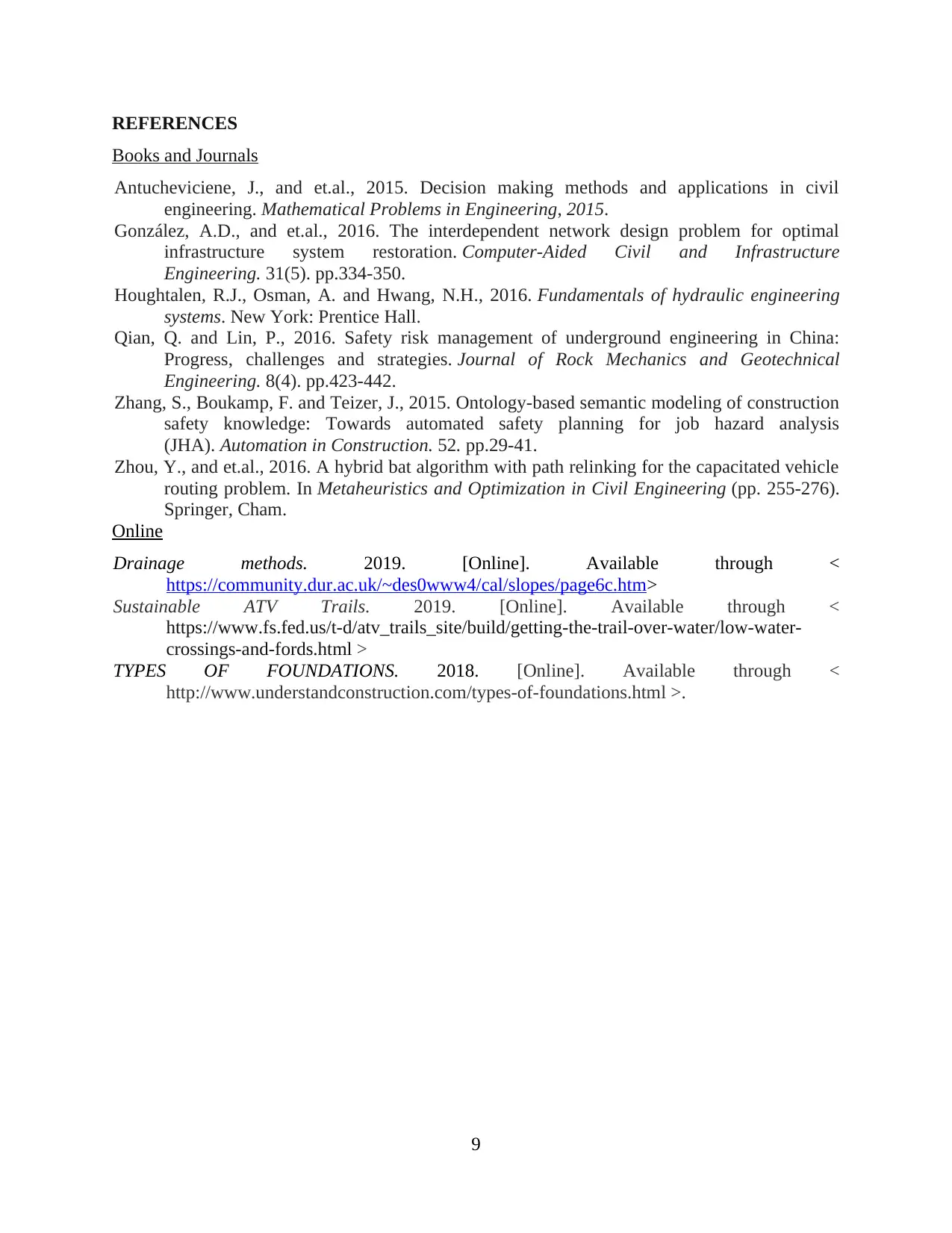
REFERENCES
Books and Journals
Antucheviciene, J., and et.al., 2015. Decision making methods and applications in civil
engineering. Mathematical Problems in Engineering, 2015.
González, A.D., and et.al., 2016. The interdependent network design problem for optimal
infrastructure system restoration. Computer‐Aided Civil and Infrastructure
Engineering. 31(5). pp.334-350.
Houghtalen, R.J., Osman, A. and Hwang, N.H., 2016. Fundamentals of hydraulic engineering
systems. New York: Prentice Hall.
Qian, Q. and Lin, P., 2016. Safety risk management of underground engineering in China:
Progress, challenges and strategies. Journal of Rock Mechanics and Geotechnical
Engineering. 8(4). pp.423-442.
Zhang, S., Boukamp, F. and Teizer, J., 2015. Ontology-based semantic modeling of construction
safety knowledge: Towards automated safety planning for job hazard analysis
(JHA). Automation in Construction. 52. pp.29-41.
Zhou, Y., and et.al., 2016. A hybrid bat algorithm with path relinking for the capacitated vehicle
routing problem. In Metaheuristics and Optimization in Civil Engineering (pp. 255-276).
Springer, Cham.
Online
Drainage methods. 2019. [Online]. Available through <
https://community.dur.ac.uk/~des0www4/cal/slopes/page6c.htm>
Sustainable ATV Trails. 2019. [Online]. Available through <
https://www.fs.fed.us/t-d/atv_trails_site/build/getting-the-trail-over-water/low-water-
crossings-and-fords.html >
TYPES OF FOUNDATIONS. 2018. [Online]. Available through <
http://www.understandconstruction.com/types-of-foundations.html >.
9
Books and Journals
Antucheviciene, J., and et.al., 2015. Decision making methods and applications in civil
engineering. Mathematical Problems in Engineering, 2015.
González, A.D., and et.al., 2016. The interdependent network design problem for optimal
infrastructure system restoration. Computer‐Aided Civil and Infrastructure
Engineering. 31(5). pp.334-350.
Houghtalen, R.J., Osman, A. and Hwang, N.H., 2016. Fundamentals of hydraulic engineering
systems. New York: Prentice Hall.
Qian, Q. and Lin, P., 2016. Safety risk management of underground engineering in China:
Progress, challenges and strategies. Journal of Rock Mechanics and Geotechnical
Engineering. 8(4). pp.423-442.
Zhang, S., Boukamp, F. and Teizer, J., 2015. Ontology-based semantic modeling of construction
safety knowledge: Towards automated safety planning for job hazard analysis
(JHA). Automation in Construction. 52. pp.29-41.
Zhou, Y., and et.al., 2016. A hybrid bat algorithm with path relinking for the capacitated vehicle
routing problem. In Metaheuristics and Optimization in Civil Engineering (pp. 255-276).
Springer, Cham.
Online
Drainage methods. 2019. [Online]. Available through <
https://community.dur.ac.uk/~des0www4/cal/slopes/page6c.htm>
Sustainable ATV Trails. 2019. [Online]. Available through <
https://www.fs.fed.us/t-d/atv_trails_site/build/getting-the-trail-over-water/low-water-
crossings-and-fords.html >
TYPES OF FOUNDATIONS. 2018. [Online]. Available through <
http://www.understandconstruction.com/types-of-foundations.html >.
9
1 out of 11
Related Documents
Your All-in-One AI-Powered Toolkit for Academic Success.
+13062052269
info@desklib.com
Available 24*7 on WhatsApp / Email
![[object Object]](/_next/static/media/star-bottom.7253800d.svg)
Unlock your academic potential
Copyright © 2020–2025 A2Z Services. All Rights Reserved. Developed and managed by ZUCOL.


